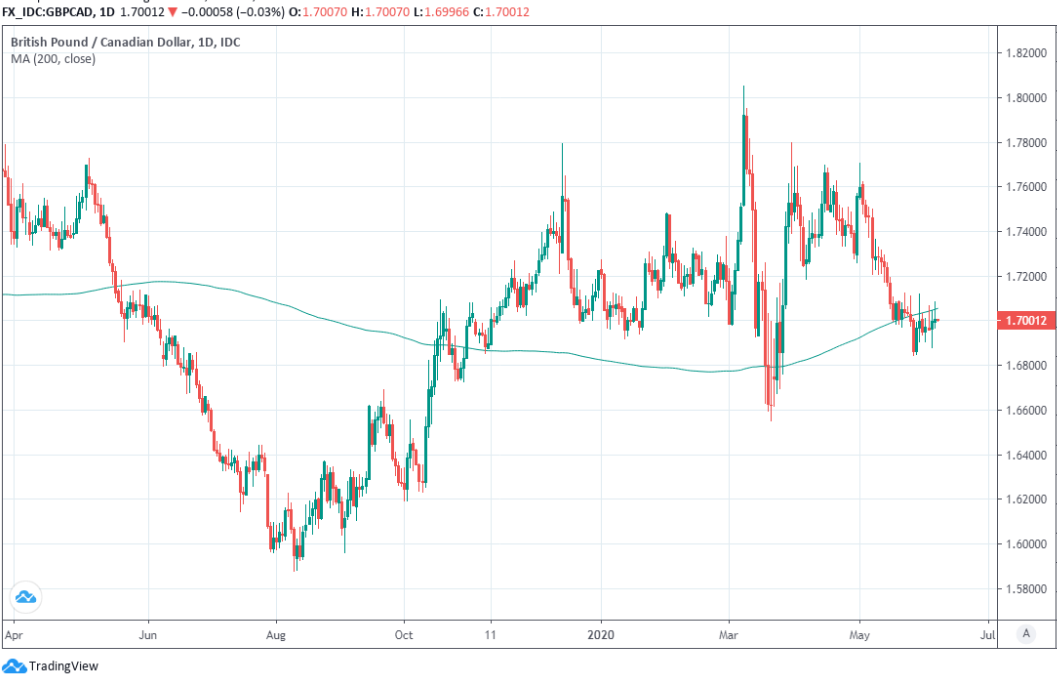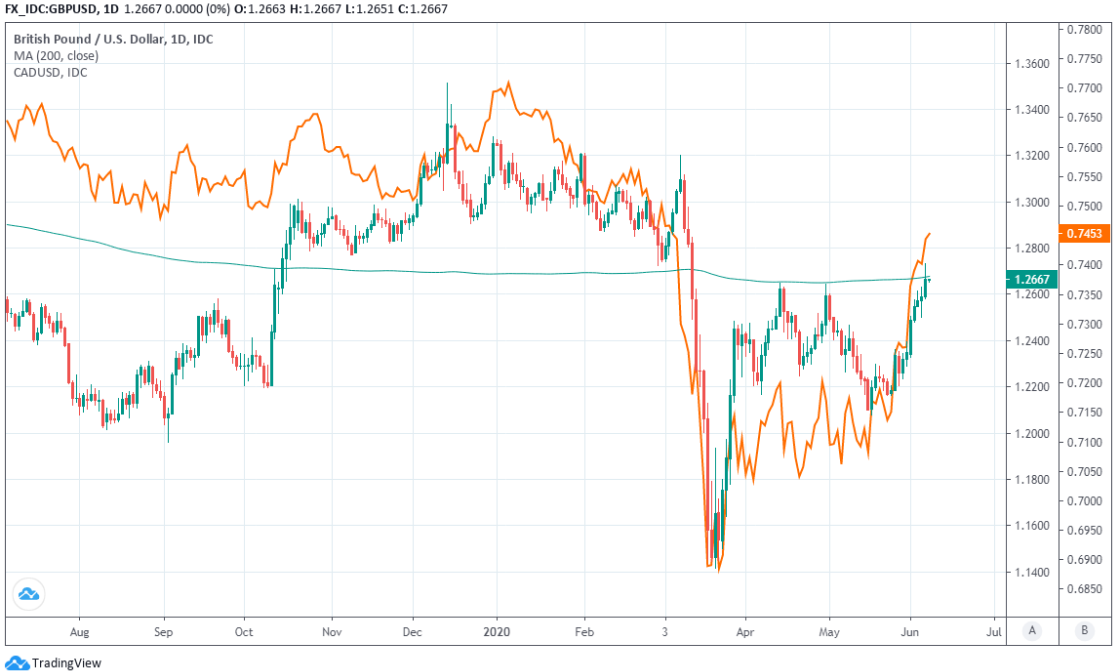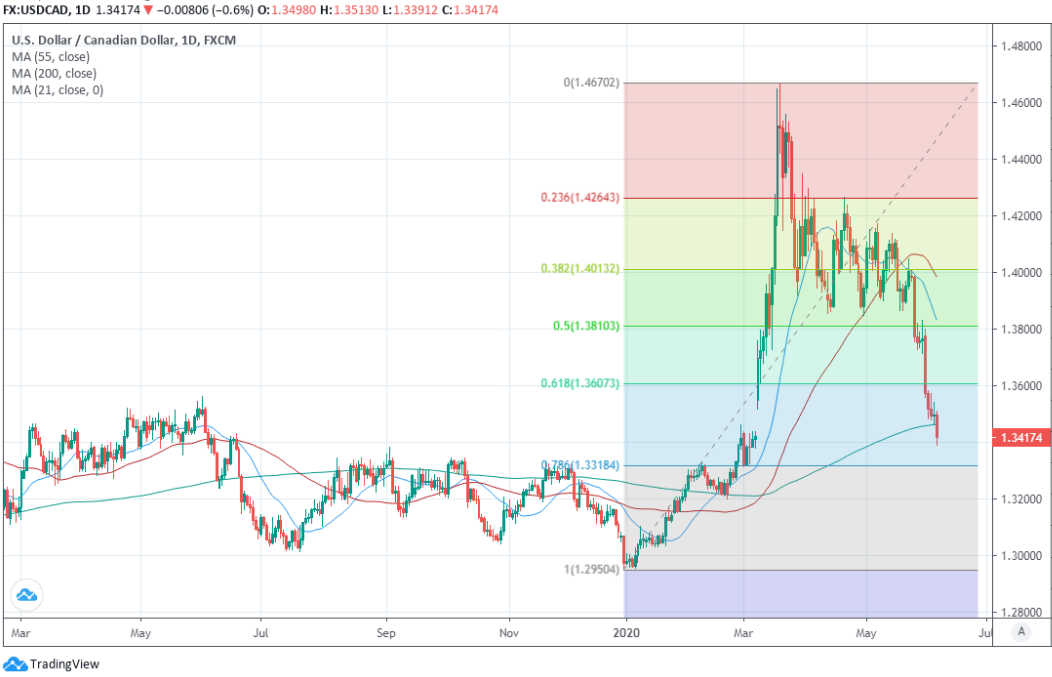Pound-to-Canadian Dollar Week Ahead; Buckling at the Knees as Loonie Shifts Up a Gear
- Written by: James Skinner
-
- GBP/CAD knees risk buckling after North American job surprises.
- USD/CAD down through 200-day average as GBP/USD blocked.
- U.S., CA jobs surprises give CAD fresh momentum, fuel its rally.
- All obvious pathways lead GBP/CAD lower for the week ahead.

Image © Adobe Stock
- GBP/CAD at time of writing: 1.7002
- Bank transfer rates (indicative guide): 1.6400-1.6524
- FX specialist rates (indicative guide): 1.6600-1.6850
- More on acquiring specialist exchange rates here
The Pound-to-Canadian Dollar rate could buckle at the knees this week after Friday's show-stopping jobs reports gave the Loonie a fresh lease of life that means Sterling now needs to run even faster than it has done in recent times, just to avert fresh declines against its Canadian counterpart.
Pound Sterling's losses slowed last week but it still suffered a fifth weekly decline against the Canadian Dollar after Friday afternoon's Brexit boost faded quickly ahead of the weekend, with the Loonie gathering steam following a May jobs report that confounded market expectations. GBP/CAD had traded higher during the noon session but was found a fraction lower at 1.7002 by the close, leaving it with a minor loss of -0.14% for the week.
Canada's job market came back with a bang last month when it created 289.6k new jobs in the face of expectations for a -500k loss, which constrained the unemployment rate and marked the beginning of the country's labour market repair. The jobless rate rose from 13% to 13.7% rather than the 15% anticipated by consensus while Canada's Dollar celebrated alongside the U.S. greenback, which also benefited from its own shock increase in employment.
"While the data will be subject to scrutiny, they support the notion that the North American economy has seen the worst of the pandemic impact – even if full recovery remains distant. The US payrolls report helped lift US equity markets meaningfully while the Canadian numbers lent credence to the constructive tone outlined by the Bank of Canada in its policy statement Wednesday," says Shaun Osborne, chief FX strategist at Scotiabank.
North American jobs data has confirmed that both economies began their respective recoveries last month and have provided a further boost to stock markets and oil prices, which the Canadian Dollar has a direct exposure to, after 'lockdown' measures were eased in May. Meanwhile, and over in the UK, many restrictions remain in place until mid-June with much of the services dominated economy still shut down while Brexit also remains a headwind.
Above: Pound-to-Canadian Dollar rate at daily intervals with 200-day moving-average.
The Canadian Dollar already offered investors higher short-term bond yields than the U.S. Dollar and Sterling but now it also comes with a labour market and economic recovery that's yet to be observed in the UK, which could mean that if there's anyone currency that can hold its own against a steadying U.S. Dollar this week, the Loonie is a better candidate for it that Sterling.
The Dollar Index steadied Friday as the U.S. currency took back lost ground from the lower yielding Yen, Euro and Swiss Franc. This was while GBP/USD scored only a 0.27% gain that paled into insignificance when stood next to the -0.74% fall seen by USD/CAD, with price action in the two explaining the the decline in the Pound-to-Canadian Dollar rate.
"CAD remains heavily influenced by equity market trends, in keeping with recent patterns, but firmer crude oil prices are helping at the margin. In addition, we note a constellation of CAD-positive developments on our charts below, including relatively better Canadian data surprises over the US, USD-negative seasonal trends and USD-bearish technical pointers which suggest to us that USDCAD is likely to continue heading lower in the near-to-medium term while the USD will likely struggle to rally," Osborne writes in a research note Friday.
Above: GBP/USD and CAD/USD at daily intervals with 200-day moving-average.
What matters most for the Pound-to-Canadian Dollar outlook is the relative pace of gains or losses in GBP/USD and USD/CAD because it's effectively an amalgamation of those latter two exchange rates. The rub for Sterling is that Scotiabank and a range of others are growing more bearish in their outlook for USD/CAD, which broke beneath and closed below its 200-day moving-average on Friday while GBP/USD stalled ahead of its own equivalent, which also argues for a lower GBP/CAD rate.
After falling below its 200-day moving average last week the next obvious layer of support for the Canadian Dollar is the 1.34 level followed by the 78.6% Fibonacci retracement of the March-to-April spike in the exchange rate located at 1.3317, although some analysts say the Canadian Dollar could push USD/CAD all the way to 1.30 over the coming days and weeks.
"The CAD has lagged so far in the recovery phase leaving potentially more room for catch up strength ahead. USD/CAD has fallen back into the 1.3000 to 1.3500 range and could yet test the bottom of that range. The price of oil has clearly bottomed which is consistent with a global recovery. Western Canada Select has almost fully reversed the sharp sell-off in March as it has moved back towards USD30/barrel. It provides a more solid foundation for the CAD to extend its recent rebound. At the same time, the latest employment data from the US and Canada has provided encouragement that the worst is over for North American economies as job growth resumed in May," says Derek Halpenny, head of research, global markets EMEA and international securities at MUFG.
Above: USD/CAD rate shown at daily intervals with 200-day moving-average and Fibonacci retracements of March rally.
This is thoroughly bearish news for Sterling if not accompanied by further offsetting gains in GBP/USD. The GBP/USD rate would need to rise from 1.2672 to 1.2822 in order to prevent the Pound-to-Canadian Dollar rate from falling in a world where USD/CAD is trading down at 1.3317. If Sterling fails to advance against the greenback early this week and instead hugs its 200-day average at 1.2675, like some suggest that it might do, GBP/CAD would fall to 1.6879 if USD/CAD trends down to 1.3317.
If the Canadian Dollar pushes USD/CAD back to 1.30, the GBP/USD rate has to run even faster just in order to keep the Pound-to-Canadian Dollar rate still. Even if Sterling rose all the way to its own 1.30 handle against the Dollar at the same time, the Pound-to-Canadian Dollar rate would still be facing declines and promptly found trading down at 1.6900. Even lower if rather than rising against the greenback, Sterling just held steady or went into a fresh retreat.
The Pound-to-Canadian Dollar rate would be found trading more than 5% lower at 1.6478 if GBP/USD remains around 1.2672 while the Canadian Dollar pushes USD/CAD to 1.30 and the losses would grow larger still if Sterling happens to weaken against the greenback.
All of these possible scenarios imply not only weakness in the Pound-to-Canadian Dollar rate, but also that its legs could be about to buckle. Especially as Brexit and the Bank of England (BoE) remain live threats that may yet return to haunt the British currency over the coming weeks.
Above: Pound-to-Canadian Dollar rate at weekly intervals with Fibonacci retracements of referendum downtrend.













